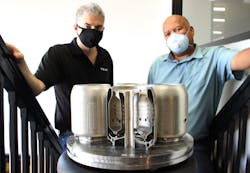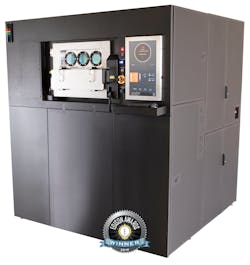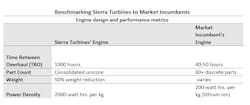Flying high with 40X reliability: Sierra Turbines aims to move the small-engine industry forward
Roger Smith is breaking the rules of manufacturing. The chief executive officer of San Jose, California-based Sierra Turbines Inc., he’s discarded the industry’s long-held belief that additive manufacturing (AM) is limited to prototyping and low-volume work. In fact, Smith plans to additively manufacture 95% or more of his microturbine components even when he reaches large-scale production.
Apple to aircraft
Smith doesn’t care that he’s discarding several other industry beliefs, among them the notion that overhauling microturbines every 40 to 50 hours is acceptable.One of the key pillars of this advanced technology in Smith’s arsenal is the metal AM system from manufacturer VELO3D, located just a few minutes south of Sierra Turbines in Campbell. Says Smith, “We opened the company in 2017, and within the first year or so had pretty much scoured the planet for a 3D-printing process to produce our parts. That’s when we learned about VELO3D. We were all quite surprised—and pleased—to discover they are just down the street from us. It makes our work together that much easier.”
The “we” in this story is Smith’s team of scientific and technical professionals. Some have gas turbine expertise; others are extremely knowledgeable in software and control systems (Smith himself spent 19 years with Apple before launching Sierra Turbines). All have worked in Fortune 100 product environments. Together they boast a combined 70 years of industry experience, with each team member sharing the same goal—to design and manufacture better solutions for the burgeoning microturbine market.
Microturbines are suitable for a variety of applications, Smith explains. They can be used to meet land-based power generation needs, where microturbine-based systems not much larger than a washing machine serve as auxiliary power units (APUs) in backup generators and other standby electrical-generation needs.
They are also of importance for unmanned aerial vehicles, or UAVs. Where gas turbine engines weighing many thousands of pounds push commercial and military aircraft through the skies every day, microturbines perform a less dynamic, though just as important, task: powering the electric motors that keep UAVs aloft. They can also be used to charge the batteries that drive those motors, as range extenders, or in hybrid UAVs that alternate between batteries and motors.
The Aurelius Mk1 Project
Sierra Turbines named their microturbine “Aurelius Mk1,” drawing on that historical period when engines were named after Greek or Roman mythology. Inspired by the Rolls Royce Olympus engines that first powered the Concorde supersonic airliner, Aurelius also happens to be the name of Smith’s late father. Sierra Turbines intends to honor that namesake by challenging the status quo.
The time between overhaul (TBO) for most small turbine engines averages 40 to 50 hours. Smith intends to raise that value to 1000+ hours, on par with commercial aircraft. He also plans to reduce engine weight to a kilogram or less, cut noise, and improve fuel efficiency, all while making the turbines easier to manufacture. These are lofty goals, yet ones shared by practically everyone making microturbines. He’s confident that his team will succeed where others have failed, however, through a host of design improvements only made possible with advanced metal AM.
Smith sees his efforts as part of a bigger picture, work that will contribute towards a revitalization of the country’s manufacturing sector. “My thoughts are these,” he says. “If we as a country are to start building products in the U.S. again, we must develop better ways of designing and fabricating products. This includes less reliance on tooling, most of which has been shifted to China, but also an embrace of Industry 4.0 and other change-making technologies. Metal 3D printing is one of these change-makers. It’s far less wasteful than traditional manufacturing and presents endless opportunities for part consolidation, lightweighting, greater product efficiency…the list goes on.”
One example of this new approach to design efficiency is the Aurelius combustor. It’s the heart of any microturbine and the test case by which Smith would determine which providers were able to deliver on the promise of additive. The component contains hundreds of small, oddly shaped holes, delicate mesh-like webbing, dozens of internal cooling channels, and a series of thin, exceedingly tall walls. And where the initial design contained 61 discrete parts, that number fell to a consolidated “unicore” engine after Sierra Turbine's designers gave it an additive makeover with computational modeling software tools.
Key differentiators
It's this highly sophisticated design that Smith presented to various additive equipment manufacturers, challenging them to build the part from Hastelloy® X, a high-strength, low-creep metal that's favored by commercial-aircraft manufacturers. The heat-resistant superalloy is also vital to Smith's reliability and fuel-efficiency goals, as it will allow his engine to reach temperatures previously unattainable in microturbines. "The hotter you go in any gas turbine, the better the performance," he says.
Smith isn’t naming names, except to say that "everyone else failed" in their attempts to build the thin-walled, high-aspect-ratio combustor. “The team at VELO3D worked with us on the design, tweaking things to make it more manufacturable, but it was their Flow software that was perhaps the biggest enabler,” Smith says, “It contains a number of special tools that provide valuable feedback throughout the entire print-preparation process.
He noticed a range of hardware differentiators as well. “It was obvious to me early-on that the VELO3D platform offers a different approach to laser powder-bed fusion (LPBF)," he adds. “For starters, their non-contact recoater blade is especially well-suited to print thin-walled sections—in some areas, our walls are less than one millimeter thick, and these tended to break off on other 3D printers.”
Smith also notes VELO3D’s ability to eliminate supports on shallow overhangs. This attribute provides for internal features that would otherwise be impossible to produce, as well as the smooth surface finishes printed by the Sapphire metal AM system. Each of these reduces the need for secondary machining and other finishing processes, something the team at Sierra Turbines wishes to avoid wherever possible.
Finally, the system’s quality assurance software, Assure, documents all the critical sensor data that affect part quality and produces a comprehensive build report for traceability. Armed with data points concerning protrusions, oxygen level, filter life, and laser alignment, Sierra Turbines has confidence that the part built was indeed a good part. “This level of quality assurance is what will move the AM industry forward,” notes Smith.
Reducing the pain of traditional manufacturing
The cost and energy savings by the consolidation of 61 parts into one part cannot be overstated. Production and transport of different raw materials, manufacture of individual parts using different processes, shipping of individual parts, tedious assembly work, joints of dissimilar materials, reliance on extra seals or fasteners, and more: All of this waste is simply eliminated by the integration of many parts into one printed part which subsequently requires minimal post-processing. “3D printing eliminates a great deal of manufacturing pain,” Smith says.
Ready for takeoff
Smith is just getting started. Once the combustor has been thoroughly tested and benchmarked, he intends to pursue additional performance improvements. He's also planning to work on the microturbine's rotating components, an unorthodox move that many aerospace pundits would agree is beyond the pale. Here again, Smith is determined. “VELO3D believes that you can use additive for full-scale production, and so do I,” he says.
Nor is his decision solely a matter of lower cost, shorter lead-times, or abbreviated supply chains. By allowing Sierra Turbines to consolidate dozens upon dozens of components into a single 3D-printed piece, one with lower mass and greater mechanical integrity than the welded and assembled alternative, support-free printing technology is enabling this small company to meet its design goals. Smith fully expects to meet or exceed his TBO goal of 1000 hours, among other objectives.
“I believe that technology should be a servant to the design, not the other way around,” Smith says. “My design team is freed from the constraints of traditional manufacturing and even existing metal AM technologies such that they can focus purely on defining the geometry needed to maximize performance and differentiation. For future gas turbine development, we aim to leverage the power of additive manufacturing to integrate features such as an efficiency-boosting recuperator, printed-in sensors, and more novel insulating and cooling geometries.”
Kip Hanson is a freelance writer and manufacturing consultant in Tucson, AZ. With over 30 years in manufacturing and business management, he covers a wide range of topics, from anything machining or fabrication-related, to consumer products, oil and gas, CAD/CAM/FEA and ERP systems. You can reach him at [email protected]


